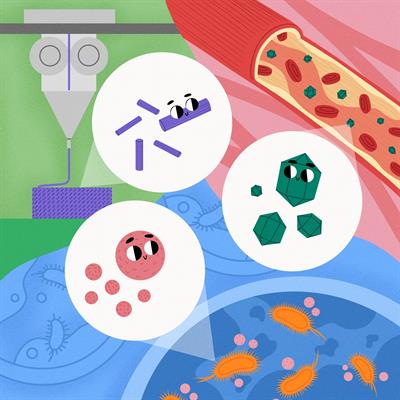
Nanotechnology - The Invisible World
Collection Editors
Tarryn Botha, Muthumuni Managa, Edward NxumaloViews
44,242 viewsParticipating Sections
Submission Deadline
Closed
Articles

Engineering and Technology
28/02/2025
What are Nano-Based Products and Who Uses Them?
Authors
Lutfiyya Latief, Heinrich Theodor Jacob Dahms, Annemariè...
Earth Sciences
27/11/2024
Do Nanoparticles Affect Crop Growth and Soil...
Authors
Busiswa Ndaba, Haripriya Rama, Ashira Roopnarain
Engineering and Technology
05/09/2024
Using Nanomaterials to Make Better Batteries
Authors
Yared S. Worku, Ludwe L. Sikeyi, S. A. Olalerua...
Human Health
30/08/2024
Is “Small” Safe? Exploring the Good and Bad of...
Authors
Charlene Andraos, Kailen Boodhia, Tarryn Lee Botha
Engineering and Technology
29/08/2024
Sizes, Shapes, and Types of Nanomaterials
Authors
Nichole Donough, Victor Wepener, Tarryn Lee Botha
Engineering and Technology
31/07/2024
Can Nanoparticles Be Used to Boost Biogas...
Authors
Ashira Roopnarain, Haripriya Rama, Busiswa Ndaba
Human Health
16/07/2024
A New Way to Treat Diseases Using Light-Loving...
Authors
Muthumuni Managa, Tracy G. T. Moraba, Nonkululeko Malomane...
Engineering and Technology
11/07/2024
Filtration: Making Dirty Water Clean Enough to...
Authors
Mabore Jerida Raseala, Meladi Lerato Motloutsi, Funeka...About this collection


This Collection will focus on all aspects of nanotechnology. Did you, for example, know that the nanoscale ranges between 1–100 nm, which is a million times smaller than an average ant! In this Collection, we will provide a brief history of nanotechnology, including what it is and what nanomaterials look like. Articles will illustrate ways that nanotechnology can be used to improve human lives.
When manufacturing nanomaterials, we can change many of their properties also known as their characteristics. Nanomaterials can exist in various shapes, such as spheres, rods, stars, or even tubes. By changing the shape, composition, or size of a nanomaterial, we can change its functions. One famous example, the buckyball, is a carbon-based nanomaterial that looks like a cage; it can be used as a lubricant, or medicines can be loaded within it. Whenever we choose to use nanomaterials, we must first ensure that they are safe for all living things and the environment.
The development of nanotechnology holds great promise for future technological developments. As a fast-developing field, the products of nanotechnology can be found in all aspects of our lives, including food, cosmetics, electronics, and paint. In this Collection, we will explain how nanotechnology can be used to remove pollutants from our water or to develop energy-storage systems, describe how biosensors work, and discuss the challenges faced in ensuring the safe use of nanomaterials.
Would you like to submit to this collection?
For researchers interested in submitting to this Collection, please consult our author guidelines and check that you have all the essentials included before submitting















